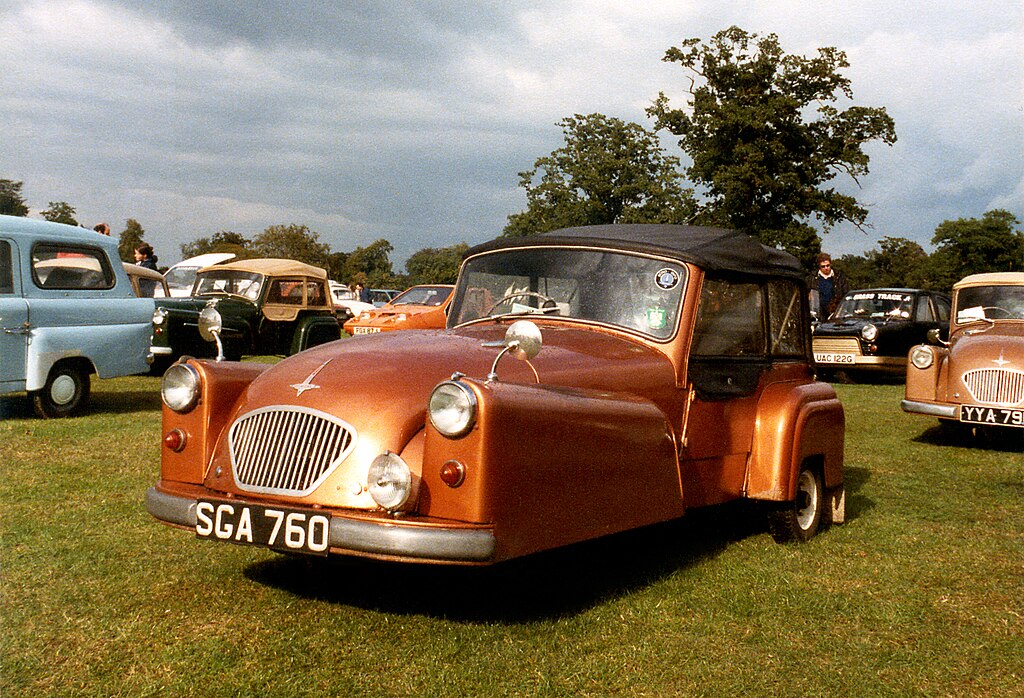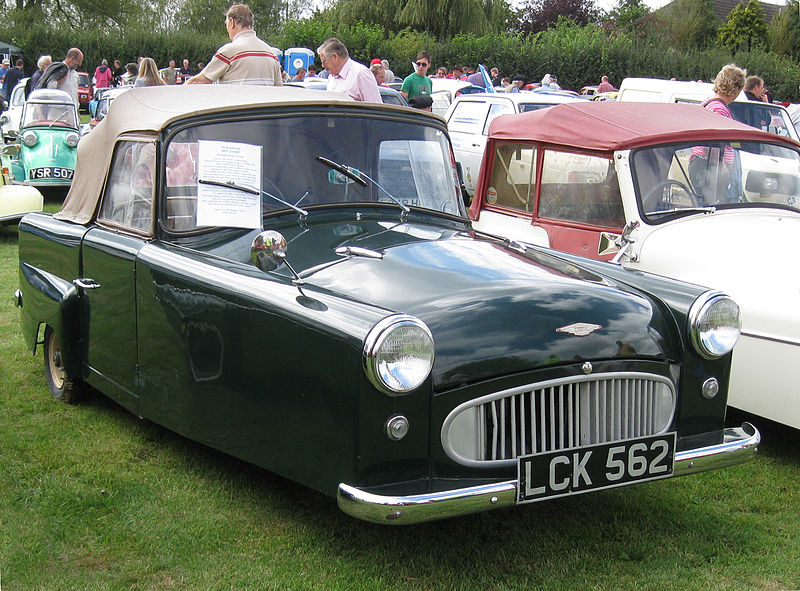Bond Minicar is a series of economical three-wheeled microcars which were manufactured by the British car manufacturer Sharp's Commercials Ltd (the company was renamed Bond Cars Limited in 1964), in Preston, Lancashire, between 1949 and 1966.
Minicar 1949–51
Sold as the Bond Minicar (the Mark A suffix being added only after the Mark B was introduced), the car was advertised as the world's most economical car. It was austere and simple in design, without luxuries. Production began in January 1949, although 90 per cent of the initial production was said to have been allocated to the overseas market.
Minicar Mark B 1951–52
Progressive development of the Minicar and Minicar Deluxe continued until the more significant introduction of coil sprung independent rear suspension and the much-needed Triplex Safety glass windscreen. (The Triplex windscreen was subsequently offered by Sharp's Commercials as a retro-fit kit for the earlier Minicar.) This provided an ideal opportunity to relaunch the car as the Bond Minicar (Mark B) in July 1951.
Minicar Mark C 1952–56
Around the same time as the Mark B was launched, work had begun on what was referred to subsequently as a "streamlined version" of the Minicar. Badged as the 'ESC' (England's Smallest Car), this prototype utilised the main body and rear suspension of the Mark B, but added mock front wings, a passenger side door and a valance beneath its oval-shaped grille.
Minicar Mark D 1956–58
In May 1956, the Mark C was discontinued and the Mark D introduced. The changes between the last Mark Cs and the Mark D are, like those between the final Mark As and the Mark B, almost entirely hidden from view and the cars are externally identical. Beneath the Mark D bonnet however, Villiers had substantially upgraded the 197 cc (12 cu in) engine, which now became the Mark 9E. The main changes were a 4-plate clutch, a heavier final drive chain with simplified adjustment and a higher top-gear ratio. The 9E was said to produce a 12½ per cent increase in power over the 8E,[60] providing a claimed 8.4 bhp (6 kW; 9 PS) at 4,000 rpm. This increased the cruising speed to around 45 mph (72 km/h), with a top speed of 51 mph (82 km/h).[61] Electrics were upgraded from 6 volt to 12 volt, allowing more powerful headlights with separate side-lights within the headlamp units. All Deluxe models include the SIBA Dynastart. Other changes which had been gradually introduced onto Mark Cs over the years, were carried over to the Mark D. This included items such as strengthened rear suspension, chrome side flashes on the front wings of Deluxe models and larger rear lights with integrated rear reflectors. As well as the slight weight increase, Sharp's also noted that ground clearance on the Mark D was now only 6.5 in (170 mm) compared to the Mark C's 7 in (180 mm).
Minicar Mark E 1956–58
Announced on 31 October 1956 as a late addition to the 1957 range, the Mark E was radically different in design from any previous Minicar.
A deliberate attempt to introduce "modern car lines", the Mark E introduced semi-monocoque construction, both to improve the resilience of the car and to allow full-height doors to be fitted on both sides. As announced, the prototype car was completely flat-sided and as with previous models used light alloy for all exterior panels. Beneath the skin, there were two main steel frames, one which made up the principle support for the floor, rear suspension and doors and a second which carried the steering assembly and engine. This second frame was described as "semi-floating" to allow the damping out of engine vibrations and to prevent fractures. Further strength was obtained by separating the bonnet from the front grill, allowing the grill frame to add rigidity to the front of the car.Track and overall width of the car were the same as the Mark D, but the wheelbase was extended by 12 in (300 mm). Though not appreciated at the time, this fundamentally affected the car's stability and made it liable to overturn. Weather protection was more sophisticated, the hood now including a front section that could be rolled back as a sunroof while the detachable side screens incorporate sliding windows. The seat was still a single bench, but the backrest was now split, one third allowing for adjustment to suit driver comfort, whilst the remainder hinged forward to allow access to the boot. Lighting was improved with larger headlamps, flashing indicators and rear number plate light. The fuel tank was increased in size to 3.25 imp gal (15 l), but the car retained the Villiers 9E/3 engine with three-speed gearbox. Deliveries of the new car were expected to begin in May 1957.
Minicar Mark F 1958–63
The November 1958 London Motorcycle show was used to launch the Minicar Mark F. As with the change from the Mark C to D, the designation was primarily to denote significant mechanical progression from the Mark E rather than any notable difference in the cars external appearance. Three versions of the new model were shown, the Mark F Tourer, the Mark F Saloon Coupe and the Mark F 4-Seater Family Saloon. The Tourer and Coupe were identical to the Mark E versions but the 197 cc (12 cu in) Villiers 9E engine was replaced by a 247 cc (15 cu in) Villiers 31A. Though this engine boasted 12 bhp (9 kW; 12 PS) at 4,500 rpm (an increase of 3.6 bhp (3 kW; 4 PS)), the fuel consumption, dimensions and weight of the unit were almost identical to the 9E. Tests during the summer of 1958 included climbing a 28 per cent gradient "without a struggle" and stop and restart tests two-up on the same slope. Top speed was given as 55 mph (89 km/h) with an average fuel consumption of 60 mpg‑imp (4.7 L/100 km; 50 mpg‑US). The 4-Seater Family Saloon was identical to the Coupe from the outside, but inside, the rear deck was cut back to allow space for a forwards facing hammock style rear seat, just big enough for two children. Unlike the similar seats in the Mark D Family, this could be completely detached for load carrying. All three models offered optional reverse gear.
Minicar Mark G 1961–66
Billed extensively as the "new-line" Minicar, the final evolution of the Bond Minicar was still based to a large extent on the bodyshell of the Mark F. Nevertheless, a revised shape fibreglass roof, new doors, new windscreen with opening quarter lights and bigger wheels largely transformed the cars appearance. However, although the car was similar in layout to the Mark F, almost everything mechanically about the Mark G was different with very few components carried over.
Bond Bug
The Bond Bug is a small British two-seat, three-wheeled automobile which was built from 1970 to 1974, initially by Bond Cars Ltd, but subsequently by the Reliant Motor Company. It is a wedge-shaped microcar, with a lift-up canopy and side screens instead of conventional doors.Following the purchase of Bond Cars Ltd., Reliant commissioned Tom Karen of Ogle Design to design a fun car. The Bond Bug was based on chief engineer John Crosthwaite's newly designed chassis and some Reliant Regal running gear. The original concept was explored by chopping down a production Regal vehicle, the rear of the car being shortened to end over the rear axle.
The engine is the front-mounted 700 cc (later uprated to 750 cc) Reliant light-alloy four-cylinder unit, developed from the Austin 7, and which protruded into the passenger cabin. At launch 29 bhp (22 kW; 29 PS) was claimed for the less expensive 700 and 700E models. The more up-market 700ES incorporates a redesigned cylinder head which permitted the compression ratio to be increased from 7.35:1 to 8.4:1.[ This provided a power increase to 31 bhp (23 kW; 31 PS) as well as improved torque for the then range-topping 700ES.
The Bond Bug 700ES also offers more supportive seats as well as more padding over the engine cowl, twin mudflaps, an ashtray, a rubber front bumper and a spare wheel.









.jpg/1024px-1963_Bond_250G_(16372612291).jpg)

_-_Flickr_-_mick_-_Lumix.jpg/800px-Bond_Bug_(interior)_-_Flickr_-_mick_-_Lumix.jpg)









.jfif)
No comments:
Post a Comment